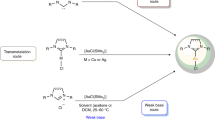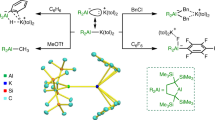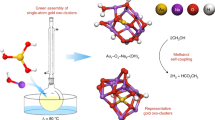Abstract
Solid-state auride salts featuring the negatively charged Au– ion are known to be stable in the presence of alkali metal counterions. While such electron-rich species might be expected to be nucleophilic (in the same manner as I–, for example), their instability in solution means that this has not been verified experimentally. Here we report a two-coordinate gold complex (NON)AlAuPtBu3 (where NON is the chelating tridentate ligand 4,5-bis(2,6-diisopropylanilido)-2,7-di-tert-butyl-9,9-dimethylxanthene) that features a strongly polarized bond, Auδ––Alδ+. This is synthesized by reaction of the potassium aluminyl compound [K{Al(NON)}]2 with tBu3PAuI. Computational studies of the complex, including quantum theory of atoms in molecules charge analysis, imply a charge at gold (−0.82) that is in line with the relative electronegativities of the two metals (Au: 2.54; Al: 1.61 on the Pauling scale). Consistently, the complex is found to act as a nucleophilic source of gold, reacting with diisopropylcarbodiimide and CO2 to give the Au–C bonded insertion products (NON)Al(X2C)AuPtBu3 (X = NiPr, 4; X = O, 5).
This is a preview of subscription content, access via your institution
Access options
Access Nature and 54 other Nature Portfolio journals
Get Nature+, our best-value online-access subscription
$29.99 / 30 days
cancel any time
Subscribe to this journal
Receive 12 print issues and online access
$259.00 per year
only $21.58 per issue
Buy this article
- Purchase on Springer Link
- Instant access to full article PDF
Prices may be subject to local taxes which are calculated during checkout






Similar content being viewed by others
Data availability
Crystallographic data for the structures reported in this Article have been deposited at the Cambridge Crystallographic Data Centre under deposition nos. CCDC 1854973 (2), 1854972 (3), 1854971 (4) and 1854974 (5). Copies of the data can be obtained free of charge from www.ccdc.cam.ac.uk/structures/. All other data supporting the findings of this study are available within the Article and its Supplementary Information, at the Oxford University Research Archive (https://ora.ox.ac.uk) and from the corresponding authors upon reasonable request.
References
Cotton, F. A., Wilkinson, G., Murillo, C. A. & Bochmann, M. Advanced Inorganic Chemistry 6th edn (Wiley-Interscience, Hoboken, NJ, 1999).
Tolman, W. Activation of Small Molecules (Wiley-VCH, Weinheim, 2006).
Cornils, B. & Herrmann, W. Applied homogeneous catalysis with organometallic compounds (Wiley-VCH, Weinheim, 1996).
Bacci, M. et al. Transition Metal Complexes—Structures and Spectra (Springer, Berlin, 2014).
Hieber, W. & Leutert, F. Äthylendiamin-substituierte Eisencarboyle und eine neue Bildungsweise von Eisencarbonylwasserstoff (XI. Mitteil. über Metallcarbonyle). Chem. Ges. 64, 2832–2839 (1931).
Elschenbroich, C. & Gerson, F. Metal π complexes of benzene derivatives. VI. Bis(η-benzene)vanadium(−I) anion. J. Am. Chem. Soc. 97, 3556–3557 (1975).
Ellis, J. E. Adventures with substances containing metals in negative oxidation states. Inorg. Chem. 45, 3167–3186 (2006).
Jansen, M. The chemistry of gold as an anion. Chem. Soc. Rev. 37, 1826–1835 (2008).
Jansen, M. Effects of relativistic motion of electrons on the chemistry of gold and platinum. Solid State Sci. 7, 1464–1474 (2005).
Andersen, T., Haugen, H. K. & Hotop, H. Binding energies in atomic negative Ions: III. J. Phys. Chem. Ref. Data 28, 1511–1533 (1999).
Sommer, A. H. Alloys of gold with alkali metals. Nature 152, 215 (1943).
Spicer, W. E., Sommer, A. H. & White, J. G. Studies of the semiconducting properties of the compound CsAu. Phys. Rev. 115, 57–62 (1959).
Peer, W. J. & Lagowski, J. J. Metal-ammonia solutions. 11. Au−, a solvated transition metal anion. J. Am. Chem. Soc. 100, 6260–6261 (1978).
Dietzel, P. D. C. & Jansen, M. Synthesis and crystal structure determination of tetramethylammonium auride. Chem. Commun. 621, 2208–2209 (2001).
Tsui, E. Y., Müller, P. & Sadighi, J. P. Reactions of a stable monomeric gold(i) hydride complex. Angew. Chem. Int. Ed. 47, 8937–8940 (2008).
Schmidbaur, H. & Dash, K. C. Compounds of gold in unusual oxidation states. Adv. Inorg. Chem. 25, 239–266 (1982).
Mézailles, N. et al. Gold(i) and gold(0) complexes of phosphinine‐based macrocycles. Angew. Chem. Int. Ed. 38, 3194–3197 (1999).
McIntosh, D. & Ozin, G. A. Synthesis of binary gold carbonyls, Au(CO)n (n = 1 or 2). Spectroscopic evidence for isocarbonyl(carbonyl)gold, a linkage isomer of bis(carbonyl)gold. Inorg. Chem. 16, 51–59 (1977).
Weinberger, D. S. et al. Isolation of neutral mono‐ and dinuclear gold complexes of cyclic (alkyl)(amino)carbenes. Angew. Chem. Int. Ed. 52, 8964–8967 (2013).
Taylor, J. W., McSkimming, A., Moret, M.-E. & Harman, W. H. A molecular boroauride: a donor–acceptor complex of anionic gold. Angew. Chem. Int. Ed. 56, 10413–10417 (2017).
Boese, A. D., Schneider, H., Glöß, A. N. & Weber, J. M. The infrared spectrum of Au–·CO2. J. Chem. Phys. 122, 154301–154307 (2005).
Segawa, Y., Yamashita, M. & Nozaki, K. Boryllithium: isolation, characterization, and reactivity as a boryl anion. Science 314, 113–115 (2006).
Weber, L. 1,3,2‐Diazaborolyl anions—from laboratory curiosities to versatile reagents in synthesis. Eur. J. Inorg. Chem. 2017, 3461–3488 (2017).
Segawa, Y., Yamashita, M. & Nozaki, K. Boryl anion attacks transition‐metal chlorides to form boryl complexes: syntheses, spectroscopic, and structural studies on group 11 borylmetal complexes. Angew. Chem. Int. Ed. 46, 6710–6713 (2007).
Lu, W., Hu, H., Li, Y., Ganguly, R. & Kinjo, R. Isolation of 1,2,4,3-triazaborol-3-yl-metal (Li, Mg, Al, Au, Zn, Sb, Bi) derivatives and reactivity toward CO and isonitriles. J. Am. Chem. Soc. 138, 6650–6661 (2016).
Emsley, J. The Elements 2nd edn (Oxford Univ. Press, Oxford, 1995).
Hicks, J., Vasko, P., Goicoechea, J. M. & Aldridge, S. Synthesis, structure and reaction chemistry of a nucleophilic aluminyl anion. Nature 557, 92–95 (2018).
Wegner, H. A. & Auzias, M. Gold for C–C coupling reactions: a Swiss‐army‐knife catalyst? Angew. Chem. Int. Ed. 50, 8236–8247 (2011).
Mitoraj, M. & Michalak, A. Natural orbitals for chemical valence as descriptors of chemical bonding in transition metal complexes. J. Mol. Model. 13, 347–355 (2007).
Michalak, A., Mitoraj, M. & Ziegler, T. Bond orbitals from chemical valence theory. J. Phys. Chem. A 112, 1933–1939 (2008).
Radoń, M. On the properties of natural orbitals for chemical valence. Theor. Chem. Acc. 120, 337–339 (2008).
Gabbaï, F. P., Schier, A., Riede, J. & Schmidbaur, H. Different pathways of the reaction of InCl with Ph3PAuCl: isolation of the first mixed-valent mixed-metal gold/indium cluster. Inorg. Chem. 34, 3855–3856 (1995).
Puls, A. et al. A novel concept for the synthesis of multiply doped gold clusters [(M@AunM′m)Lk]q+. Angew. Chem. Int. Ed. 53, 4327–4331 (2014).
Cordero, B. et al. Covalent radii revisited. Dalton Trans. 2008, 2832–2838 (2008).
Kempter, A., Gemel, C. & Fischer, R. A. Insertion of Ga(DDP) into the Au−Cl bond of (PPh3)AuCl: a first structurally characterized Au−Ga bond. Inorg. Chem. 44, 163–165 (2005).
Green, S. P., Jones, C., Mills, D. P. & Stasch, A. Group 9 and 11 metal(i) gallyl complexes stabilized by N-heterocyclic carbene coordination: first structural characterization of Ga–M (M–Cu or Ag) bonds. Organometallics 26, 3424–3430 (2007).
Bader, R. F. W. A quantum theory of molecular structure and its applications. Chem. Rev. 91, 893–928 (1991).
Bader, R. F. W. Atoms in Molecules. A Quantum Theory (Oxford Univ. Press, Oxford, 1994).
Pinkes, J. R., Steffey, B. D., Vites, J. C. & Cutler, A. R. Carbon dioxide insertion into the iron–zirconium and ruthenium–zirconium bonds of the heterobimetallic complexes Cp(CO)2M–Zr(Cl)Cp2: direct production of the μ-η 1(C):η 2(O,O’)-CO2 compounds Cp(CO)2M–CO2–Zr(Cl)Cp2. Organometallics 13, 21–23 (1994).
Li, J., Hermann, M., Frenking, G. & Jones, C. The facile reduction of carbon dioxide to carbon monoxide with an amido‐digermyne. Angew. Chem. Int. Ed. 51, 8611–8614 (2012).
Komiya, S., Sone, T., Ozaki, S., Ishikawa, M. & Kasuga, N. Synthesis, structure and properties of dimethyl(alkoxycarbonyl)gold(iii) complexes having a triphenylphosphine ligand. J. Organomet. Chem. 428, 303–313 (1992).
Gaillard, S., Nun, P., Slawin, A. M. Z. & Nolan, S. P. Expeditious synthesis of [Au(NHC)(L)]+ (NHC=N-heterocyclic carbene; L=phosphine or NHC) complexes. Organometallics 29, 5402–5408 (2010).
Acknowledgements
This work was supported by the SCG Oxford Centre of Excellence. P.V. thanks the Magnus Ehrnrooth, Finnish Cultural and Emil Aaltonen Foundations for postdoctoral funding. Computational resources were provided by CSC – IT Center for Science, Finland, the Finnish Grid and Cloud Infrastructure (persistent identifier nrn:nbn:fi:research-infras-2016072533) and the University of Jyväskylä.
Author information
Authors and Affiliations
Contributions
J.H. carried out the synthetic and reaction studies. A.M. and P.V. carried out the computational analyses. J.H. conducted the crystallographic studies. J.H., J.M.G. and S.A. wrote the manuscript. J.M.G. and S.A. managed the project.
Corresponding authors
Ethics declarations
Competing interests
The authors declare no competing interests.
Additional information
Publisher’s note: Springer Nature remains neutral with regard to jurisdictional claims in published maps and institutional affiliations.
Supplementary information
Supplementary Information
General considerations and starting material preparations; synthetic, spectroscopic and analytical data; 1H-NMR spectra; X-ray crystallographic studies; computational studies
Crystallographic data
CIF for compound 2; CCDC reference: 1854973
Crystallographic data
CIF for compound 3; CCDC reference: 1854972
Crystallographic data
CIF for compound 4; CCDC reference: 1854971
Crystallographic data
CIF for compound 5; CCDC reference: 1854974
Rights and permissions
About this article
Cite this article
Hicks, J., Mansikkamäki, A., Vasko, P. et al. A nucleophilic gold complex. Nature Chem 11, 237–241 (2019). https://doi.org/10.1038/s41557-018-0198-1
Received:
Accepted:
Published:
Issue Date:
DOI: https://doi.org/10.1038/s41557-018-0198-1
This article is cited by
-
Coordination-induced O-H/N-H bond weakening by a redox non-innocent, aluminum-containing radical
Nature Communications (2024)
-
Structure and reactivity of germylene-bridged digold complexes
Nature Communications (2022)
-
An alkyl-substituted aluminium anion with strong basicity and nucleophilicity
Nature Chemistry (2020)
-
Bimetallic cooperation across the periodic table
Nature Reviews Chemistry (2020)
-
Changing the gold standard
Nature Chemistry (2019)



